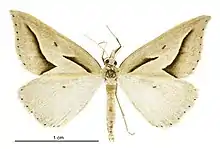| Samana acutata | |
|---|---|
 | |
| Male | |
| Scientific classification | |
| Kingdom: | |
| Phylum: | |
| Class: | |
| Order: | |
| Family: | |
| Genus: | |
| Species: | S. acutata |
| Binomial name | |
| Samana acutata | |
Samana acutata is a species of moth in the family Geometridae This species is endemic to New Zealand. It is classified as "At Risk, Relict" by the Department of Conservation.
Taxonomy
This species was first described by Arthur Gardiner Butler in 1877 using a specimen that was collected from Christchurch, in the South Island and was obtained from J. D. Enys.[2][3] George Hudson discussed this species in his 1898 book New Zealand moths and butterflies (Macro-lepidoptera).[4] He later discussed and illustrated this species in his 1928 book The Butterflies and Moths of New Zealand.[5][6] The holotype specimen is held at the Natural History Museum, London.[6]
Description
.jpg.webp)
Butler described the species as follows:
Primaries pale straw yellow ; an oblique interno-basal litura, a dot at the end of the cell, and a discal transverse line terminating in an acute < -shaped angle, piceous ; the discal line diffused externally ; a marginal series of black dots ; secondaries white, with the fringe creamy; a marginal series of black dots; thorax pale straw yellow, abdomen white : primaries below pale testaceous, whitish on internal area ; markings (excepting the marginal dots, which are united by a slender brown line) only visible through the wing ; secondaries white, the costal area tinted with testaceous, and sparsely irrorated with brown ; a small black dot at the end of cell ; a marginal series of black dots ; fringe creamy : body below pale straw yellow. Expanse of wings 1 inch 2 lines.[2]
Distribution
This species is endemic to New Zealand.[1][7] S. acutata can be found in Mid Canterbury and Central Otago.[3] It is now extinct at its type locality.[3]
Life cycle and behaviour
Larvae of this species have been found in January and in March.[8][9] The adult is on the wing in September and October.[10] Hudson stated this species is attracted to light.[5]
Host species and habitat
The host species for this moth are the New Zealand native brooms in the genus Carmichaelia including Carmichaelia australis and Carmichaelia appressa.[3][9][11] The species is known to inhabit dune ecosystems.[12] It has also been found in habitat containing gorse and mānuka.[5]
Conservation status
This moth is classified under the New Zealand Threat Classification system as being "At Risk, Relict".[13] This species is threatened as a result of change of habitat, in particular the loss of its host species due to farming and urban development.[3] It is also at risk from weed invasion from plants such as sea spurge.[12]
References
- 1 2 "Samana acutata Butler, 1877". www.nzor.org.nz. Landcare Research New Zealand Ltd. Retrieved 2018-05-17.
- 1 2 Butler, A. G. (1877). "On two collections of heterocerous Lepidoptera from New Zealand, with descriptions of new genera and species". Proceedings of the Zoological Society of London: 379–407 – via Biodiversity Heritage Library.
- 1 2 3 4 5 Patrick, B.H.; Dugdale, J.S. (2000). Conservation status of the New Zealand lepidoptera (PDF). Wellington, N.Z.: Department of Conservation, New Zealand. ISBN 047821867-2. Retrieved 18 May 2018.
- ↑ Hudson, G. V. (1898). New Zealand moths and butterflies (Macro-lepidoptera). London: West, Newman & Co. p. 76. doi:10.5962/bhl.title.7912. Retrieved 6 February 2017.
- 1 2 3 Hudson, G. V. (1928). The Butterflies and Moths of New Zealand. Wellington: Ferguson & Osborn Ltd. p. 133.
- 1 2 Dugdale, J. S. (1988). "Lepidoptera-annotated catalogue, and keys to family-group taxa" (PDF). Fauna of New Zealand. 14: 192 – via Landcare Research New Zealand Ltd.
- ↑ Gordon, Dennis P., ed. (2010). New Zealand inventory of biodiversity: Kingdom animalia : chaetognatha, ecdysozoa, ichnofossils. Vol. 2. p. 460. ISBN 978-1-877257-93-3. OCLC 973607714. OL 25288394M. Wikidata Q45922947.
- ↑ Patrick, B. (January 1982). "Lepidoptera of Danseys Pass, Otago". New Zealand Entomologist. 7 (3): 332–336. doi:10.1080/00779962.1982.9722418.
- 1 2 Patrick, B. (1994). "Lepidoptera of Kaitorete Spit, Canterbury". New Zealand Entomologist. 17 (1): 52–63. CiteSeerX 10.1.1.580.6402. doi:10.1080/00779962.1994.9721985.
- ↑ Pawson, S. M.; Emberson, R. M. (2000). "The conservation status of invertebrates in Canterbury". Researchgate. Retrieved 7 May 2018.
- ↑ Patrick, H.J.H.; Bowie, M.H.; Fox, B.W.; Patrick, B.H. (2011). "The moths of Quail Island (Otamahua): a faunal comparison of an island under restoration with other sites on Banks Peninsula" (PDF). New Zealand Natural Sciences Journal. 36: 57–72. Archived from the original (PDF) on 2016-03-03. Retrieved 2018-05-18.
- 1 2 Duthie, Catherine (2012). Risk Analysis: Euphorbia paralias – sea spurge. ISBN 978-0-478-40435-7. Retrieved 18 May 2018.
{{cite book}}:|website=ignored (help) - ↑ Hoare, R.J.B.; Dugdale, J.S.; Edwards, E.D.; Gibbs, G.W.; Patrick, B.H.; Hitchmough, R.A.; Rolfe, J.R. (2017). Conservation status of New Zealand butterflies and moths (Lepidoptera), 2015 (PDF). Wellington, New Zealand: New Zealand Department of Conservation. p. 8. ISBN 9781988514383.
